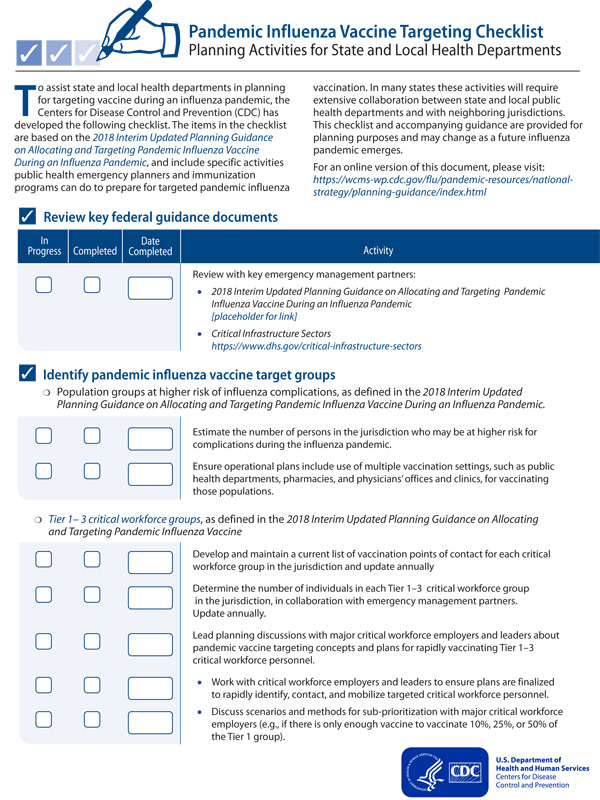Implementation of this Guidance during a Future Pandemic

As noted earlier, numerous decisions on vaccine allocation will be required as information about the epidemiology and impact of the pandemic and vaccine supply issues evolve. ACIP will provide recommendations to the director of the CDC (and revise recommendations, if needed), regarding use of stockpiled and pandemic vaccine after a pandemic virus emerges. Adapting this guidance to such an evolving situation will require close interagency coordination and clarity on the roles that various agencies will play.
Seven discrete activities may be needed, and some will occur simultaneously:
- Determine Severity: Public health scientists at CDC will collect and analyze epidemiologic and laboratory data to determine pandemic severity using the PSAF1. This analysis will be reviewed and revised as necessary as more information about the virus and its impact becomes available. With a focus on community impact and the likelihood of broad absenteeism, this information will be critical to guide the approach taken to vaccine allocation and targeting.
- Recommend Vaccine Viruses: The World Health Organization (WHO) Collaborating Centers will recommend the appropriate pandemic virus for use in vaccine manufacturing. The Food and Drug Administration’s (FDA) Vaccine and Related Biological Products Advisory Committee (VRBPAC) will review the WHO recommendation and make a recommendation to the Commissioner of Food and Drugs at FDA for viruses to include in the pandemic vaccine for the United States. In addition, VRBPAC will assess vaccines in the U.S. pandemic stockpile and determine whether vaccine in the stockpile should be used for vaccine priming and/or boosting.
- Recommend Vaccine and Identify High Risk Groups: An assessment will also be needed to identify groups at increased risk of severe illness from pandemic influenza; these groups may differ from groups at high risk of severe illness from seasonal influenza. For a pandemic of any severity, the ACIP will recommend vaccine use and develop guidance regarding groups at higher risk for complications and risk of exposure to pandemic influenza virus infection, based on the epidemiology of the emerging pandemic. This guidance from ACIP will be incorporated, upon adoption by the CDC director, into the overall U.S. plan for pandemic vaccine allocation and targeting. The number of people in these groups may also change and need to be reassessed as the U.S. population grows over time.
- Assess Tiers for Vaccination: If the severity of the pandemic is projected to be severe or very severe, the U.S. government may develop additional guidance, based on ACIP’s recommendations, for allocating and targeting pandemic vaccine to certain groups (as outlined in this document). These additional recommendations will be based on an assessment of the impact of the pandemic on critical functions of society and availability and timing of pandemic vaccine. As previously mentioned, recommendations issued during a pandemic may differ from the planning schema as presented in Table 1.
- Determine Vaccine Formulation: Results of clinical trials conducted by HHS, and other available data, will be used to determine the appropriate formulation of a pandemic vaccine (e. g., specific virus(es), antigen content, whether an adjuvant is required, and dosage) and number of doses required to elicit a protective immune response. Clinical trial results will inform any adjustments needed in the targeting strategy and FDA-licensure of a pandemic vaccine.
- Monitor Vaccine Availability: Allocation of pandemic vaccines by the U.S. government to states and territories will likely be in proportion to state’s populations. Following initial allocation and targeting recommendations and the start of vaccine delivery, HHS will conduct a weekly review of information provided by the vaccine manufacturers on the status of vaccine supply, information from states and territories on vaccine demand, and the evolving epidemiology of the pandemic in the United States and globally. Based on this weekly review, HHS will periodically reassess recommendations for allocating and targeting vaccine and when to expand vaccination to additional tiers as vaccine supply increases, demand for vaccination changes, or information on the epidemiology and impact of the pandemic changes. State, local, and territorial immunization programs will have the ultimate responsibility for implementing this guidance, but given the likely variation in vaccine demand among states, it is necessary to have a flexible approach to respond to local needs.
- Communicate Regularly: Timely and comprehensive communication with the public and with stakeholder groups through the entire process of developing and implementing the vaccination recommendations is critical to the success of the program.


